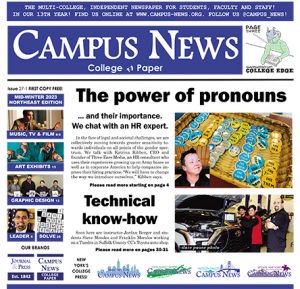By Nancy M. Scuri
Campus News
In the face of legal and societal challenges, we are collectively moving towards greater sensitivity towards individuals on all points of the gender spectrum. While we still have far to go in terms of equality and acceptance, we can find ourselves in unfamiliar territory regarding terms and situations. This is especially true on campus and in the workplace. The Human Rights Campaign Foundation reminds us “Nothing may be more personal than the way in which people refer to us through our name and pronouns. Using a person’s chosen name and desired pronouns is a form of mutual respect and basic courtesy. Everyone deserves to have their self-ascribed name and pronouns respected in the workplace.” But how do we put this into practice on campus and in the workplace?
Katrina Kibben (pictured), CEO and founder of Three Ears Media, is an HR consultant who uses their experiences growing up on Army bases as well as in corporate America to help companies improve their hiring practices. Campus News sat down with Katrina to discuss how we can best support ourselves and those around us as we express our true selves. (The interview has been edited for clarity and length.)
CN: First off, what do we mean by pronouns? We know He/She from English class, but it’s more than that, yes?

KK: There are several pronouns that extend outside of the binary. Here are the basics:
She/Her/Hers and He/Him/His – These are the pronouns you already know and although our brains are trained to use them, you may find that some folks use a label that doesn’t match your perceptions of gender. This is why it is so important to open the door during conversation/introductions to allow for folks to share the pronouns that feel best for them.
She/They or He/They – Chances are, these folks identify with a healthy balance of masculine and feminine energy. In all cases, you should integrate both pronouns as often as possible. Use “they” and “them” every so often in circumstances where you would normally use “she” and “her”.
They/Them/Theirs, Ze/Zir/Zirs, and Ze/Hir/Hirs – Many folks who use these pronouns identify as non-binary, meaning they do not feel particularly drawn to either masculinity or femininity. Some might use these pronouns if they are feeling detached from the gender they were assigned at birth. Regardless of the reasoning, those using they/them pronouns should ONLY be referred to as “they” and “them.”
CN: There has been a great deal of resistance from some quarters regarding the use of correct pronouns and not deadnaming. How can cisgender friends and family be better allies?
KK: Ask people “how should I refer to you” and practice. One of the ways to build that muscle memory is to repeat someone’s pronouns 3 times in your head when you use the wrong one. That repetition has been shown to help. Also, correcting others even when the other people are not around. You can be an ally without an audience.
CN: If someone decides they want to let others know that they wish to be referred to in a way that is more in line with who they are, what are some ways they can let that be known, especially if it includes “new information” for friends and family?
KK: There’s not a one size fits all answer to this. Coming out is unique, special, and really hard for some people. I wish I had a better answer, but this journey is really personal.
CN: That’s understandable. If a friend or family member comes out to us, is there anything we can do to make things easier for them?
KK: Educate yourself. Read books. Talk about what you learned to them and everyone you know. Show vs. tell them you are an ally.
CN: What are some good rules of thumb in regard to pronouns in the academic/professional setting?
KK: Ask “how should I refer to you” not “what are your pronouns?” Include education and links that are helpful to our education on pronouns when adding them to your email signature. Remember that when cisgendered people add their pronouns, it creates normalcy around pronoun usage. It can’t just be non-binary people sharing. Know that using pronouns can be as simple as this:
“Hello, my name is _____, my pronouns are________. How should I refer to you?”
CN: We seem to be moving towards being more open to accepting people as they are, including how they identify themselves. How may this affect people entering the workforce in the next few years in regard to interacting with their coworkers and management?
KK: We will have to change the way we introduce ourselves. Also, organizations should provide more education to employees to assure that everyone knows what a pronoun is, how to correct themselves if they misgender someone, and offer resources to support allyship behaviors every day.
CN: Thank you! Is there anything else we should know?
KK: I do not use the word “preferred” when talking about pronouns. Preferences are for foods, not identity.
For more information on pronoun education, go to www.threeearsmedia.com
Nancy Scuri is a freelance writer and editor with over fifteen years of teaching experience at the college level. You can reach her at nancyscuri.substack.com.








Facebook Comments